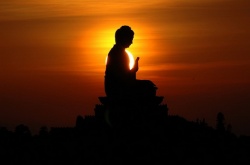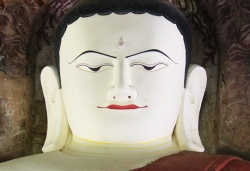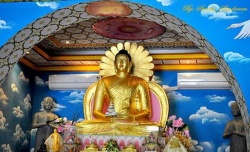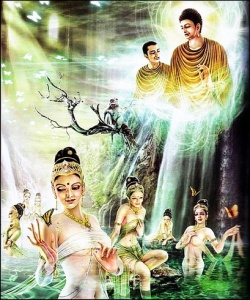The Three-Kaya Powa
This teaching was transmitted to Guru Chen by Lama Norna. I received the oral transmission from Guru Chen on the 24th of July 1981 at the Sunset View Cemetery in El Cerrito, California, U.S.A. Under the permission from Guru Chen I had written it down in Chinese in 1986 so as to make sure that the teaching would be preserved in its entirety for posterity. Guru Chen had also permitted me to make this teaching public. Now I am writing it down for the English readers. May all who have real Bodhicitta receive this teaching and become able to make use of it, thereby benefitting countless sentient beings. The publication of this teaching also serves to commemorate my late Guru Chen who went into Nirvana on the 13th of November 1987. One of Yogi Chen's booklets entitled "The Merit of Practice in a Cemetery" (No. 10 in "A Systematized Collection of Chenian Booklets Nos. One-One Hundred") talked about this practice. Interested readers are recommended to look into that booklet.
1. PRELIMINARIES
It is preferable for the practitioner to wear a formal robe to show his respect for the solemnness of this practice. Usually the better time for doing this practice is in the late afternoon or during the night. But in case you are notified of someone's passing away, you should practice it as soon as possible, regardless of what time of the day it is. Stand facing the West. If you are in a cemetery, then choose a big tree and stand under it. Light three sandal wood incense sticks and then insert them into the ground before you. Put bags of raw rice on the ground before you, and then open them up in order to receive the blessings that are forthcoming. Offerings of flowers, fruits, gold leaves, hell-bank notes, rebirth-in-the-Pureland mantras, etc. may be added. If it is to be done indoors, then you may stand facing the body, the cremated remains or the picture of the deceased instead of the West. Use incense and rice as explained above. One may use a compass to help decide the direction of the West. The offerings should be left behind in the cemetery and the rice will be used up completely in the manner described later.
2. VISUALIZATIONS
Put your palms together in front of your chest (like praying). Visualize yourself as your Yidam or Amitabha Buddha. Visulize your Guru above your head to receive the blessing of the Lineage. Visualize before you an Amitabha Buddha, facing you, of human size in red color and sitting, with cross-legs, on a lotus seat. If you know the countenance of the deceased, then visualize the face of this Amitabha Buddha as such; otherwise Amitabha Buddha's face should be the same as the one that you worship daily at home. It is a very happy face that shows eagerness in receiving the blessing. The seed word in his heart is a red Hsri (![]() )
)
First visualize the deceased to transform into a golden ray that goes into this Amitabha Buddha and then becomes identical with him. Then visualize that all the residing decedents in the cemetery transform in the same manner and become one with the Amitabha Buddha. Finally all the decedents in the Dharmadhatu are gathered in the same fashion and become one with this Amitabha Buddha.
The Amitabha Buddha in front of you is the Nirmanakaya. On top of him visualize the Sambhogakaya of Amitabha whose size is as large as the sky above. The shape of this Sambhogakaya is the same as the four-face twelve-arm Great Pleasure Vajra, but the colors are different. Both father-Buddha and mother-Buddha of this Yidam are red; and the four faces of the father-Buddha are: front red, right yellow, back dark blue, left green. The seed word in his heart is a blue Hung (![]() ).
).
On top of the Sambhogakaya visualize a even larger Adi Buddha, father and mother in union. This is the Dharmakaya of Amitabha. The seed word in his heart is a white Ah (![]() ).
).
This Powa is called "Three-Kaya Powa", because it appeals to the three Kayas of Amitabha, namely, the Nirmanakaya, the Sambhogakaya and the Dharmakaya of Amitabha Buddha.
3. RECITATIONS
While maintaining the above visualizations, recite the following prayers audibly:
- A. (Repeat three times)
GO MO DEN TAY, DAY VEE YEE SHAY PA, DZA JIANG PA,
YANG DA PA, DZO VEE SAN JAY, KA WA YIN CHEN,
DZO DU CHEN NEN, SHA MO, TSA LO.
- B. (Repeat three times)
OM AH HUNG!
CHIU KU LA MA, TA YEE LO, SO LO WA DAY,
LANG KU DOR JEE, CHAY MU LA, SO LO WA DAY,
DZO KU PAD MA, CHO MU LA, SO LO WA DAY,
JEEN JEEN DZA WEE LA MA LA, SO LO WA DAY,
SAR WA LA MA PO WA, JEEN JEEN CHEH LER, PO WA DZO PA CHU,
DZO PA AH CHIN JEH LER, DA YEE DEH NEE CHEH MU KO MA TOH,
CHEEN DA PAI SIEN,KER GEE NEE LA,
JU DA KER WA, ER, SO--OH.
4. DELIVERANCE
Inhale as much as possible. Shout out "HEE!" and visualize the Nirmanakaya to transform into a golden ray that is shot up into the Hung in the heart of the Sambhogakaya. Inhale to the full extent again. Shout out "PAY!" and visualize the Sambhogakaya to transform into a golden ray that is shot up into the Ah in the heart of the Dharmakaya. Thus the three Kayas of the Amitabha Buddha merge into one--the originally pure Adi Buddha. This is another reason for the name "Three-Kaya Powa." Do the above wind-practice for a total of three times.
5. ADDITIONAL RECITATIONS
The above constitutes the main practice of this Three-Kaya Phowa. To make sure that all decedents in the Dharmadhatu are delivered, the practitioner adds the following recitations to grant more blessings:
(Repeat each mantra below three times)
- MA MA KU LING SA MAN DA
(meaning carefree from all sorrows)
- AH AH SHA SA MA HA
- C. the Mantra of Adi Buddha
- AH, DHAR MA DHA TU, AH
- OM AH HUNG SO HA
- E. the Six-Syllable Mantra of Avalokitesvara
- OM MA NEE PEH MEE HUNG
- OM PAN DZA PA NEE HUNG PAY
- OM AH MEE DA WA SHEH
- H. the Mantra of Vajrasattva
- OM PAN DZA SA DOH HUNG
NAMO OH MEE DOH PO YEH,
DOH TOH CHAY DOH YEH, DOH DEE YEH TOH,
OH MEE LEE DOH PO PEE,
OH MEE LEE DOH, SHEE DAN POH PEE,
OH MEE LEE DOH, PEE CHA LANG DEE,
OH MEE LEE DOH, PEE CHA LANG DOH,
CHIA MEE NEE, CHIA CHIA NOH,
DZ DAN CHEH LEE, SO POH HO.
(this mantra may be recited six times, signifying the deliverance of the beings in the six realms.)
6. SPREADING THE BLESSING
Each one present takes a bag of rice that has just received the blessing of this practice, and each walks in different directions. Throw the rice onto the graves, visualize that the blessing of Amitabha Buddha comes to the decedents as the rice falls onto the graves, and, all the while, recite "OM MA NEE PEH MEE HUNG". Also visualize that all the decedents in the Dharmadhatu are receiving the blessings as the rice falls. If this practice is performed indoors, then throw the rice at the forehead, the throat and the center of the chest of the deceased, or on the image of the deceased, or on the urn that contains the cremated remains of the deceased, or visualize the deceased in front and throw rice at him. The rest of the rice should be thrown outdoors to benefit all decedents in the Dharmadhatu.
The above teachings were gathered by me through several occassions of requesting for and receiving teachings from my Guru. On the first occassion, Guru Chen practiced the Phowa and transmitted the recitations to me. Then I went home and memorized the recitations by repeating after him, using a tape recording of his transmission of this teaching. On the second occassion, Guru Chen just taught me the general idea of the visualizations. The details in the visualizations were revealed only later, when, through practice, I discovered the gaps. Then in 1986 I learned from my Guru that this Three-Kaya Phowa can be used, not only for the deliverance of others, but also for the deliverance of oneself. Three-Kaya Phowa for One's Own Deliverance
Visualize oneself as Amitabha Buddha with his Sambhogakaya and Dharmakaya on top of one another. All facing the East. Then practice this Powa according to sections 3 and 4 above.
Before practicing this Phowa, for others or oneself, one should first learn about the teachings related to Phowa in general, e.g. the importance of practicing the Long-Life Buddha Sadhana after Phowa practice, etc.
Source
Oral transmission by Yogi C. M. Chen
Written by the Lineage Successor Yutang Lin
yogichen.org




